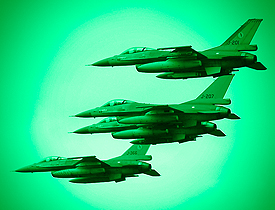An average air force stands to save millions of euro on training costs thanks to a new training simulation program that increases the realism and effectiveness of fighter jet training. An added advantage of this new way of training is that it eases the environmental burden. The Embedded Combat Aircraft Training System (ECATS) developed by Dutch Space and NLR to maturity in May 2012 can be fitted in all fighter jets.
Virtual fighter jet training in combat situations has been possible for many years, but until now it was confined to sitting in a simulator on the ground. All pilots will additionally always have to do a significant amount of their training in the air. But it is expensive to mobilise a realistic and challenging combat environment because of the need to deploy enemy units in the air and on the ground. An innovative system called ECATS developed by Dutch Space and National Aerospace Laboratory NLR has elevated tactical training to a higher level. ECATS is a training simulator system integrated in the operating system of a fighter jet. During training flights the system enables pilots to train in simulated combat scenarios with virtual airborne enemies and ground threats. Pilots are also able to operate as a team, with four of them jointly training a combat action in a multi-ship configuration of ECATS.
Everywhere, anytime
This kind of training requires no infrastructure, so it is possible anywhere, anytime. It is even possible to execute a scenario above the North Sea, a relatively small area for exercises where it is practically impossible to install ground threats.
Cost effective
ECATS can significantly reduce training costs because fewer aircraft are needed for deployment as opposing forces. Conservative estimates indicate potential savings of 15% on the operational costs and fuel of these ‘red air flights’. Alternatively, the value of training can be increased by using these savings for training flights. This can easily increase the effectiveness of the annual exercise program by millions of euro for an average-sized air force. Less ‘red air flights’ will also ease the environmental burden.
More training per flying hour
ECATS can enhance the effectiveness of training still further by making a mission more complex. Expressed in euro this added value represents another 15% increase in effectiveness. The earn-back time on the procurement of ECATS is typically just a few years based on these percentages.
 Future developments
Future developments
ECATS can be developed onwards for use in helicopters, like the NH90. Another development is making the virtual enemies even more realistic, for all fighter jet simulations and not just Embedded Training. The objective of a separate project called ‘Smart Bandits’ is to make the virtual enemy ‘more human’ so as to make enemy behaviour more realistic and increase the return on training.

